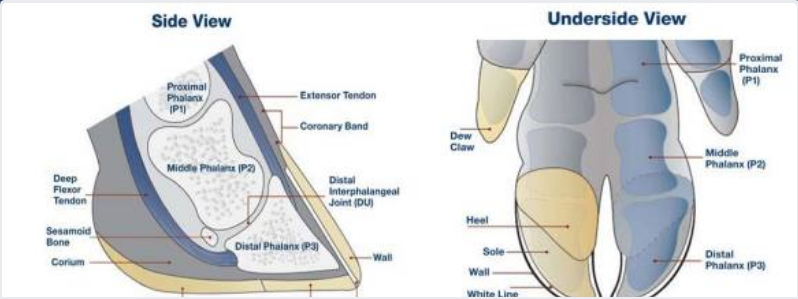
This affects all age groups from growers, gilts, sows and boars. It is caused by diet and poor floors and effects Lameness, claw defects, poor growth, diarrhoea, hair loss, scaly skin, small litters.
Causes
Dietary biotin (a water-soluble B vitamin) is normally present in adequate amounts in pig rations, although in feeds containing wheat or barley, the vitamin may be less readily available to pigs than in maize-based diets. Biotin is a cofactor in a number of body enzymes especially in the carboxylation (a chemical reaction in which a carboxylic acid group is produced by treating a substrate with carbon dioxide) or transcarboxylation reactions required for energy metabolism. In growing pigs lipogenesis (fat formation) is affected when the important enzyme, Acetyl CoA carboxylase cannot be formed. Deficiency in biotin on wheat and barley-based rations occurs quite commonly and at least 180 mg/tonne should be present for health.
Mode of transmission
Biotin deficiency is not infectious and occurs where rations are deficient in the vitamin.
Clinical signs
Early changes in biotin deficiency are slight but include progressive hair loss, dry and scaly skin and a white film and transverse grooves on the tongue. After 5-7 weeks on a deficient diet, claw defects occur. Erosion of the heel occurs first and is followed by cracking of the sole. Cracks appear in the now rubbery horn of the sole and the claw wall and result in lameness. Secondary infection may occur. In most cases, foot lesions in sows appear on the underside of the hoof and are only seen when the claw is cleaned. Others appear as longitudinal cracks on the wall originating in the coronary band. Heel and sole erosions and cracks also occur. Inspection of the sows’ feet after thorough cleaning will allow the claw defects to be seen clearly. Cracks arising from the coronary band and erosions of the sole and heel and the presence of alopecia and scaly skin suggest biotin deficiency. As the foot lesions could be mistaken for those of a vesicular disease, such disease should be ruled out. There may be alopecia and a dry scaly skin which may progress to give dermatitis with brownish crusts and pinpoint haemorrhages. The reproductive effects include low numbers born, especially born alive and reared and long weaning to service intervals. Reproductive effects measured over 4 parities indicate at 1-1.4 pigs per sow per year are lost, that weaning to service intervals may be increased by up to 4 days and that conception to the first service may be reduced by 9%. Good recording is essential for this effect to be detected.
Treatment and prevention
A diagnosis of biotin deficiency can be confirmed by analysing the biotin content of the ration (100-220 µg/kg is the normal range) and noting the response to biotin supplementation of the diet. The reproductive effects can be confirmed only by supplementation of the diet in controlled studies. Populations with plasma levels of 60 ng/100 ml benefit from supplementation.
When deficiencies occur it is common practice to supplement the diet with 400 mg-1,250 mg/tonne of D-biotin; it is best to seek the advice of an experienced pig nutritionist. Biotin is available as a 1% d-biotin premix and 40g premix/tonne is necessary for most purposes, for growing gilts, and pregnant and lactating sows to prevent foot lesions and improve litter size. Levels up to 3,000 mg/tonne may be necessary to reverse hoof lesions and time should be allowed for the damaged horn to grow out.